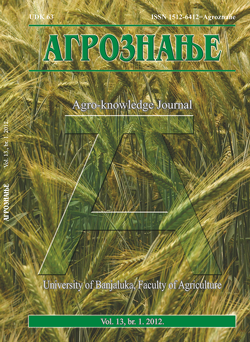Changing the Albanian subsidy policy in the context of low-profit farms
DOI:
https://doi.org/10.7251/AGREN1201061CAbstract
Since 2005, the Government of Albania has been providing subsidies for competitive sectors of the agriculture, mostly fruit growing. However, there is a general lack of data regarding farm revenues, profitability and competitiveness and the criteria are not very restrictive in terms of orchard size or capital. The purpose of this research was to study the competitiveness of fruit tree farms. The study was conducted from 2009 – 2011 in the Vlora region by collecting financial information from 70 fruit tree farms, distributed at different levels of altitude and slopes, both features having an impact on the choice of crops, cultural practices and market access. The average income of rural families in the Vlora region (proxy for the Reproduction Threshold) acted as a reference against which the economic viability of farming systems was evaluated. In general, despite the farm typology, location and differences in net incomes, the farms under study had low net incomes, where 95 percent were under the reproduction threshold. This was mainly due to their small farm surface and, consequently, low productivity. Therefore, there is a lack of ability to accumulate capital and intensify the production, maintaining the extensive type of fruit growing. Under these conditions, 60 percent of the farmers interviewed were involved in other secondary agricultural activities to increase their sustainability, making these farms more competitive than the specialised ones. Although the orientation of subsidises to small fruit farms will offer a better guarantee to low-income categories, it will also delay restructuring of the Albanian agriculture. It may also have a negative effect on the competitiveness of the agricultural sector, in general, because the lack of readiness to sell the land will make it difficult for other farms to grow in order to reach the reproduction threshold and to take advantage of the economics of scale. In conclusion of the above results, the Government of Albania should set some criteria for the beneficiaries of subsidies in terms of farm size and capital to be invested. This would require a set of policies to create some appealing alternatives for farmers selling the land.Downloads
Published
2012-12-18
Issue
Section
Articles

